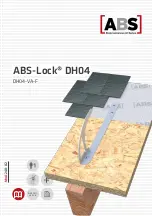
2
1
Use a pencil to mark the three screw locations
and to trace the cable-hole in the center of the
bracket.
2
Set the surface-mount bracket aside.
Do not drill through the surface-mount bracket.
3
Drill the three
1
/
8
in. (3.2 mm) pilot holes.
NotE
: If you are mounting the GPS 19x
on fiberglass, it is recommended to use a
countersink bit to drill a clearance counterbore
through the top gelcoat layer (but no deeper).
This will help to avoid cracking in the gelcoat
layer when the screws are tightened.
4
Use a 1 in. (25 mm) hole saw to cut the cable
hole in the center.
5
Place the seal pad
➋
on the bottom of the
surface-mount bracket, aligning the screw holes.
6
Use the included M4 screws to attach the
surface-mount bracket to the mounting surface.
7
Route the cable
➌
through the 1 in. (25 mm)
hole and connect it to the antenna.
8
Verify that the large gasket
➍
is in place on the
bottom of the antenna, place the antenna on the
surface-mount bracket, and twist it clockwise to
lock it in place.
9
Secure the antenna to the mounting bracket with
the included M3 set screw
➎
.
10
Route the cable away from sources of electronic
interference, and connect it to your NMEA 2000
network (
).
Mounting the Antenna on a Pole
With the included pole-mount adapter attached to the
antenna, you can install it on a standard 1 in. OD, 14
threads per inch, pipe-threaded pole (not included).
You can route the cable outside of the pole or
through the pole.
Before you permanently mount the antenna, test the
mounting location for correct operation (
Mounting the Antenna with the Cable
Routed outside of the Pole
1
Route the cable through the pole-mount adapter
➊
, and place the cable in the vertical slot
➋
along the base of the pole-mount adapter.
➊
➋
➌
2
Screw the pole-mount adapter onto a standard
1 in. OD, 14 threads per in., pipe-threaded pole
(not included).
Do not overtighten the adapter on the pole.
3
Connect the cable to the antenna.
4
Place the antenna on the pole-mount adapter
and twist it clockwise to lock it in place.
5
Secure the antenna to the adapter with the
included M3 set screw
➌
.
6
With the antenna installed on the pole mount, fill
the remaining gap in the vertical cable slot with a
marine sealant (optional).
7
Attach the pole to the boat if it is not already
attached.
8
Route the cable away from sources of electronic
interference, and connect it to your NMEA 2000
network (
).
Mounting the Antenna with the Cable
Routed through the Pole
1
Position a standard 1 in. OD, 14 threads per in.,
pipe-threaded pole (not included) in the selected
location, and mark the approximate center of the
pole.
2
Drill a hole using a
3
/
4
in. (19 mm) drill bit for the
cable to pass through.
3
Fasten the pole to the boat.
4
Thread the pole-mount adapter onto the pole.
Do not overtighten the adapter.
5
Route the cable through the pole and connect it
to the antenna.
6
Place the antenna on the pole-mount adapter
and twist it clockwise to lock it in place.
7
Secure the antenna to the adapter with the
included M3 set screw
➊
.
➊
➋
8
With the antenna installed on the pole mount, fill
the vertical cable slot
➋
with a marine sealant
(optional).
9
Route the cable away from sources of electronic
interference, and connect it to your NMEA 2000
network (
).
Mounting the Antenna under a
Surface
Notice
Before attaching the under-deck mounting bracket to
the surface, verify that the supplied screws will not
penetrate the surface. If the supplied screws are too
long, you must purchase surface-appropriate screws
to complete the installation.
Because the antenna cannot acquire signals through
metal, it must be mounted under a fiberglass surface
only.
1
Determine and test the location under a
fiberglass surface where you want to mount the
antenna (
➋
➌
➊
2
Place the adhesive pads
➊
on the under-deck
mounting bracket
➋
.
3
Place the antenna in the under-deck mounting
bracket.



































